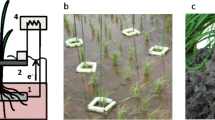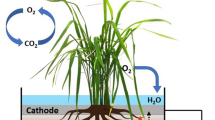Abstract
Soils are rich in organics, particularly those that support growth of plants. These organics are possible sources of sustainable energy, and a microbial fuel cell (MFC) system can potentially be used for this purpose. Here, we report the application of an MFC system to electricity generation in a rice paddy field. In our system, graphite felt electrodes were used; an anode was set in the rice rhizosphere, and a cathode was in the flooded water above the rhizosphere. It was observed that electricity generation (as high as 6 mW/m2, normalized to the anode projection area) was sunlight dependent and exhibited circadian oscillation. Artificial shading of rice plants in the daytime inhibited the electricity generation. In the rhizosphere, rice roots penetrated the anode graphite felt where specific bacterial populations occurred. Supplementation to the anode region with acetate (one of the major root-exhausted organic compounds) enhanced the electricity generation in the dark. These results suggest that the paddy-field electricity-generation system was an ecological solar cell in which the plant photosynthesis was coupled to the microbial conversion of organics to electricity.






Similar content being viewed by others
References
Atschul SF, Gish W, Miller W, Myers EW, Lipman DJ (1990) Basic local alignment search tool. J Mol Biol 215:403–410
Chin KJ, Hahn D, Hengstmann U, Liesack W, Janssen PH (1999) Characterization and identification of numerically abundant culturable bacteria from the anoxic bulk soil of rice paddy microcosms. Appl Environ Microbiol 65:5042–5049
Clauwaert P, Van der Ha D, Boon N, Verbeken K, Verhaege M, Rabaey K, Verstraete W (2007) Open air biocathode enables effective electricity generation with microbial fuel cells. Environ Sci Technol 41:7564–7569
Grosskopf R, Janssen PH, Liesack W (1998) Diversity and structure of the methanogenic community in anoxic rice paddy soil microcosms as examined by cultivation and direct 16S rRNA gene sequence retrieval. Appl Environ Microbiol 64:960–969
Ishii S, Hotta Y, Watanabe K (2008) Methanogenesis versus electrogenesis: morphological and phylogenetic comparisons of microbial communities. Biosci Biotechnol Biochem 72:286–294
Jones DL (1998) Organic acids in the rhizosphere—a critical review. Plant soil 205:25–44
Kaku N, Ueki A, Fujii H, Ueki K (2000) Methanogenic activities on rice roots and plant residue and their contributions to methanogenesis in wetland rice field soil. Soil Biol Biochem 32:2001–2010
Kaku N, Ueki A, Ueki K, Watanabe K (2005) Methanogenesis as an important terminal electron accepting process in estuarine sediment at the mouth of Orikasa River. Microb Environ 20:41–52
Logan BE, Regan JM (2006) Electricity-producing bacterial communities in microbial fuel cells. Trend Microbiol 14:512–518
Logan BE, Hamelers B, Rozendal R, Schröder U, Keller J, Freguia S, Aelterman P, Verstraete W, Rabaey K (2006) Microbial fuel cells: methodology and technology. Environ Sci Technol 40:5181–5192
Lovley RD (2006) Microbial fuel cells: novel microbial physiologies and engineering approaches. Curr Opin Biotechnol 17:327–332
Lovley DR, Phillips EJP (1987) Rapid assay for microbially reducible ferric iron in aquatic sediments. Appl Environ Microbiol 52:751–757
Ministry of Agriculture, Forestry and Fisheries (2006) Statistics of agriculture, forestry and fisheries. Ministry of Agriculture, Forestry and Fisheries, Japan
Oh S, Min B, Logan BE (2004) Cathode performance as a factor in electricity generation in microbial fuel cells. Environ Sci Technol 38:4900–4904
Reimers CE, Tender LM, Fertig S, Wang W (2001) Harvesting energy from the marine sediment-water interface. Environ Sci Technol 35:192–195
Reimers CE, Girguis P, Stecher HA III, Tender M, Ryckelynck N, Whaling P (2006) Microbial fuel cell energy from an ocean cold seep. Geobiol 4:123–136
Rezaei F, Richard TL, Brennan RA, Logan BE (2007) Substrate-enhanced microbial fuel cells for improved remote power generation from sediment-based systems. Environ Sci Technol 41:4053–4058
Sambrook J, Fritsch EF, Maniatis T (1989) Molecular cloning: a laboratory manual, 2nd edn. Cold Spring Harbor Laboratory, Cold Spring Harbor, NY, USA
Satoh A, Watanabe M, Ueki A, Ueki K (2002) Physiological properties and phylogenetic affiliations of anaerobic bacteria isolated from roots of rice plants cultivated on a paddy field. Anaerobe 8:233–246
Stookey LL (1970) Ferrozine; a new spectrophometric reagent for iron. Anal Chem 42:779–781
Takai Y (1969) The mechanism of reduction in paddy soil. Jpn Agri Res 4:20–23
Tender LM, Reimers CE, Stecher HA III, Holmes DE, Bond DR, Lowy DA, Pilobello K, Fertig SJ, Lovley DR (2002) Harnessing microbially generated power on the seafloor. Nat Biotechnol 20:821–825
Walker TS, Bais HP, Grotewold E, Vivanco JM (2003) Root exudation and rhizosphere biology. Plant Physiol 132:44–51
Watanabe K, Kodama Y, Harayama S (2001) Design and evaluation of PCR primers to amplify bacterial 16S ribosomal DNA fragments used for community fingerprinting. J Microbiol Methods 44:253–262
Watanabe K, Teramoto M, Futamata H, Harayama S (1998) Molecular detection, isolation, and physiological characterization of functionally dominant phenol-degrading bacteria in activated sludge. Appl Environ Microbiol 64:4396–4402
Yagi K, Minami K (1990) Effect of organic matter application on methane emission from some Japanese paddy fields. Soil Sci Plant Nutr 36:599–610
Acknowledgments
We thank Katsuji Ueki and Atsuko Ueki for valuable discussions, Yoichi Kikuchi and Yuka Sasaki for paddy-field management, Midori Sato for technical assistance, and Greg Newton for critical reading of this manuscript. This work was supported by Japan Society for Promotion of Science (JSPS). K.W. was also supported by Japan Science and Technology Agency (JST).
Author information
Authors and Affiliations
Corresponding author
Rights and permissions
About this article
Cite this article
Kaku, N., Yonezawa, N., Kodama, Y. et al. Plant/microbe cooperation for electricity generation in a rice paddy field. Appl Microbiol Biotechnol 79, 43–49 (2008). https://doi.org/10.1007/s00253-008-1410-9
Received:
Revised:
Accepted:
Published:
Issue Date:
DOI: https://doi.org/10.1007/s00253-008-1410-9




